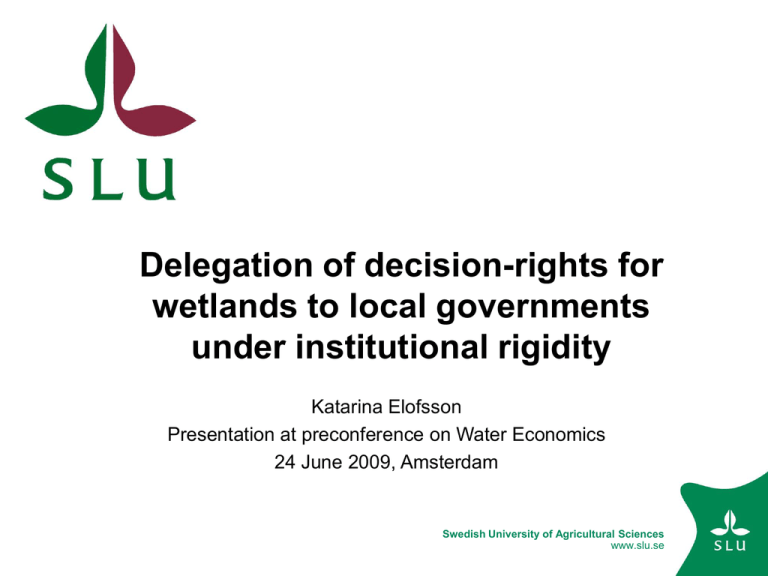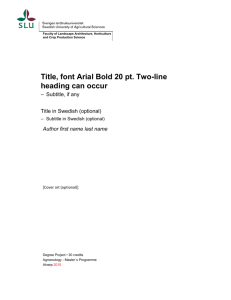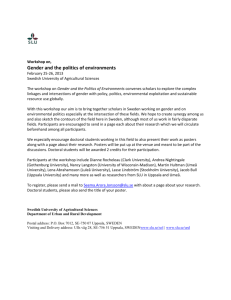Delegation of decision-rights for wetlands to local governments under institutional rigidity Katarina Elofsson
advertisement

Delegation of decision-rights for wetlands to local governments under institutional rigidity Katarina Elofsson Presentation at preconference on Water Economics 24 June 2009, Amsterdam Swedish University of Agricultural Sciences www.slu.se Introduction • Nutrient pollution damages coastal water quality. • Wetlands serve as nutrient “sinks”. • Does it matter who decides on wetland policy? Swedish University of Agricultural Sciences www.slu.se Why analyze wetland policy delegation? Motive 1: Local governments have a cost advantage compared to central (cf. e.g. d’Amato and Valentini, 2008) • • • • • Motive 2: The European Water Framework Directive (WFD) River basin management. Competent Authorities (CAs) develop operational plans. The WFD might change the allocation of decision-right between national, regional and local governments. Thus, delegation of decision-rights to local or regional level might be either a good idea or carried out anyway because of the WFD. Swedish University of Agricultural Sciences www.slu.se A closer look at motive 1: Are local governments more efficient w.r.t. wetland policy? A Swedish example. CAP (Agrienvironmental programmes) LIP (Local Investment Programmes) Decision process Central government decides on rules for support to wetland construction on farm land. Local government designs wetland projects, central government approves funding. Average cost, EUR/ha wetland 12.3 17.5 Nitrogen abatement, kg/ha and year 55-92 520-541 Phosphorus abatement, kg/ha and year 0.3-1.7 3.9-12.1 Source: Svensson et al. (2004) Swedish University of Agricultural Sciences www.slu.se The literature on hierarchical governance: I. Research questions • • • Which governmental level should prescribe policy goals (Oates and Schwab, 1996; Wellisch, 2000; Roelfsema, 2007), How could local governments be provided with incentives to choose policy instruments or carry out enforcement efficiently (Andersen and Jensen, 2003; Demski and Sappington, 1987; Miceli and Segerson, 1999) and Endogeneous drivers of delegation (Pierre and Peters, 2000). This paper addresses the first and last issue, and asks what instruments are necessary to have a socially efficient outcome. Swedish University of Agricultural Sciences www.slu.se The literature on hierarchical governance: III. Assumptions i) ii) iii) iv) Higher and lower level government have diverging objectives, because either : their constituencies differ and hence the preferences of the median voter (Oates and Schwab, 1996; Wellisch, 2000), all (or at least lower) level governments do not act to maximize the welfare of their constituencies (Demski and Sappington, 1987; Miceli and Segerson, 1999) or they possess different information (Andersen and Jensen, 2003). Moreover: Central government has a first-mover advantage (Demski and Sappington, 1987; Miceli and Segerson, 1999). In this paper, ii) and iv) are assumed. Swedish University of Agricultural Sciences www.slu.se The literature on hierarchical governance: II. Conclusions • • • • • • Delegation can be counterproductive when: There are interjurisdictional externalities There is interjurisdictional tax competition (Rauscher, 1995; Porter, 1999) …and beneficial when: Local regions have different preferences (Oates, 1998;1999; Wellisch, 2000; Ulph, 2000) Decentralization promotes institutional innovation (Oates, 2001) Social outcome can be improved through: Incentives to pool information (Andersen and Jensen, 2003) Recognition of the need to account for both strategic and other economic incentives (Miceli and Segerson, 1999) Swedish University of Agricultural Sciences www.slu.se Aim of this study Investigate how delegation of decision-rights affects: • pollution abatement and • perceived net benefits when there is: • institutional rigidity, • measures are interdependent with regard to the environmental effect and • the local government constructs wetlands that abate more pollution per EUR. Swedish University of Agricultural Sciences www.slu.se The model Agents • Two different governments, ”Central” and “Local”. • Identical benefit functions. • Each government takes only the own cost into account. • • • • Measures Three nutrient abatement measures: “Central” always decides on reductions of fertilizer nitrogen, “Local” always decides on phosphorus treatment in WWTPs and Either government could decide on wetland construction. Policy instrument • Intergovernmental matching grants for wetland construction. Swedish University of Agricultural Sciences www.slu.se Nutrient transports Nitrogen emissions from fertilizer Phosphorus emissions from WWTPs Nitrogen retention in soils and waterways Phosphorus retention in soils and waterways WETLAND Nitrogen retention in wetlands Phosphorus retention in wetlands Nitrogen and phosphorus loads to coastal waters Swedish University of Agricultural Sciences www.slu.se Structure of the game t=0 Legislature decides on • delegation of decision rights and • intergovernmental transfers. t=1 Central government chooses the level of measures under its jurisdiction. t=2 Local government chooses the level of measures under its jurisdiction. Game ends. Swedish University of Agricultural Sciences www.slu.se The central government’s decision problem in a sequential game: Swedish University of Agricultural Sciences www.slu.se Empirical data and functions • Costs and environmental effects are obtained or calculated from data in Gren et al. (2008) and Svensson et al. (2004). Benefit functions are obtained using actual policies in Sweden and assuming that policy makers equate MC and MB. • Differences in nutrient retention between governments is explained by differences in nutrient load reaching the wetland. Locally designed wetlands capture a larger load because they are better located in the landscape. • In the following, the incoming nutrient load to a wetland is used as a measure of wetland efficiency. Swedish University of Agricultural Sciences www.slu.se The “pure” strategic effect (Governments assumed identical w.r.t. benefits, costs and wetlands efficiency, no intergovernmental grants) Socially optimal solution Sequential decisions – central government decides on wetlands Sequential decisions - local government decides on wetlands 83 83 (=) 73 (↓) Wetlands, ha 2338 2335 ((↓)) 2484 (↑) Phosphorus reductions at WWTPs, ton 159 159 (=) 159 (=) Central government, Million EUR 270 270 (=) 324 (↑) Local government, Million EUR 401 401 (=) 380 (↓) Social, Million EUR 265 265 (=) 261 (↓) Measures: Nitrogen fertilizer reduction, ktons Net benefits: Swedish University of Agricultural Sciences www.slu.se The use of different measures at different levels of local government wetland efficiency 900 Use of different measures (index) 800 700 Nitrogen fertiliser reduction, tons 600 Wetlands, ha 500 Phosphorus reductions at WWTPs, ton 400 300 200 100 0 0 5 10 15 20 25 Efficiency of locally designed w etlands relative centrally designed …i.e. nothing strange here. Swedish University of Agricultural Sciences www.slu.se Net benefits at different levels of local government wetland efficiency – a tradeoff between strategic effects and wetland efficiency 400 Net benefits (index) 350 300 Central government net benefits 250 Local government net benefits 200 Social net benefits 150 100 50 0 5 10 15 20 25 Efficiency of locally designed w etlands relative centrally designed = critical level where delegation to the local government is preferred Swedish University of Agricultural Sciences www.slu.se Could intergovernmental matching grants increase social benefits? Central and local governments would be both be happy with positive grants that reduces the perceived costs of measures… but society will prefer a negative grant for wetlands! Central government’s optimization problem: Swedish University of Agricultural Sciences www.slu.se Use of measures (index) Measure use as a function of the matching grant 800 Nitrogen fertiliser reduction, tons 600 Wetlands, ha 400 Phosphorus reductions at WWTPs, ton 200 0 -1 -0.5 0 0.5 Share of wetland cost paid by central government …i.e. nothing strange here. Swedish University of Agricultural Sciences www.slu.se Net benefits as a function of the matching grant Net benefits, (index) 200 150 Central government net benefits 100 Local government net benefits Social net benefits 50 0 -1 -0.5 0 0.5 Share of wetland cost paid by central government = Socially optimal grant = Critical level where delegation to the local government is preferred → 0.2<grant<0.3 could be agreed. In this interval, social net benefits are higher if wetland policy is delegated. Swedish University of Agricultural Sciences www.slu.se Policy conclusions • If decisions are taken sequentially and the central government makes the first move, strategic behavior becomes an important determinant of the outcome. • The local government will not accept delegation without intergovernmental grants unless local wetlands are considerably more efficient than central. • A negative intergovernmental grant is socially optimal, but the local government will not accept this unless local wetland technology is very efficient. • A positive grant could make the local government accept delegation when it otherwise would not. This could imply higher benefits to society compared to letting the central government have the decision-right on wetlands. Swedish University of Agricultural Sciences www.slu.se Contribution to the literature • • Delegation can be beneficial when: the local government is more efficient in measure design, but there is a risk that local government might resist delegation Social outcome can be improved through: Renegotiation proof intergovernmental grants Swedish University of Agricultural Sciences www.slu.se




